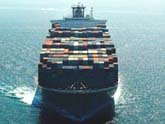For the first time since September the amount of the idle global containership capacity has fallen, according to maritime news service AXS-Alphaliner.
Idle capacity fell from 1.42 million TEUs to 1.31 million TEUs two weeks ago. Also, the number of very large containerships (VLCS) out of service fell from 23 at the beginning of April to 10 as of April 13, as carriers start redeploying ships in the belief that demand will pick up over the summer.
"The fall signals the start of the summer peak season and expectations of higher volumes in the coming months," AXS-Alphaliner said in its weekly newsletter. "A number of seasonal loops suspended a few months ago are reactivated while larger ships are introduced on other loops."
However, the lull could only be temporary as carriers are expected to have to idle ships again in fall after the peak season ends and as more new vessel deliveries arrive. The containership fleet was forecast to grow more than 10 percent this year, though it's unclear what impact delays and cancellations of vessel orders could have on that number.
Meanwhile, AXS-Alphaliner also reported that four carriers (APL, Zim, "K" Line and MISC) have idled more than 20 percent of their fleet capacity, with APL (the seventh-largest carrier) idling nearly a quarter of its fleet. For comparison, Maersk Line, MSC, CMA CGM and Evergreen (the top four lines) have idled 8, 1, 2 and zero percent, respectively.
MSC is particularly noteworthy in that its fleet capacity has actually grown 11.6 percent since September 2008, due to new deliveries and minimal idling of existing ships. Three other carriers -- Yang Ming Line, Hamburg Süd and UASC -- have also seen their fleets expand since September.
American Shipper













